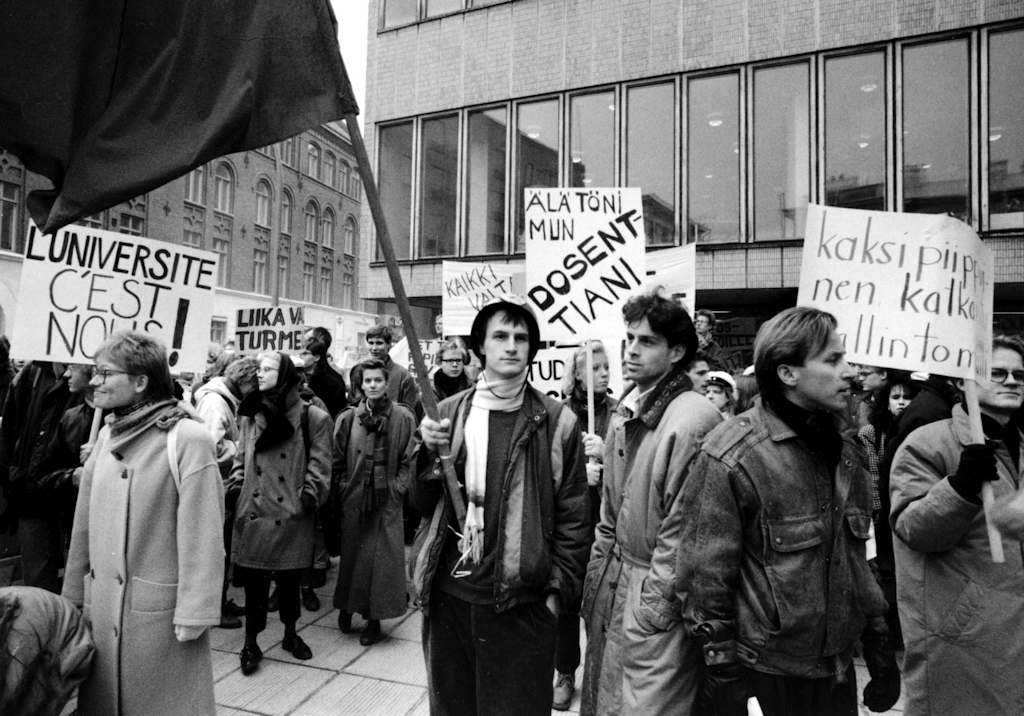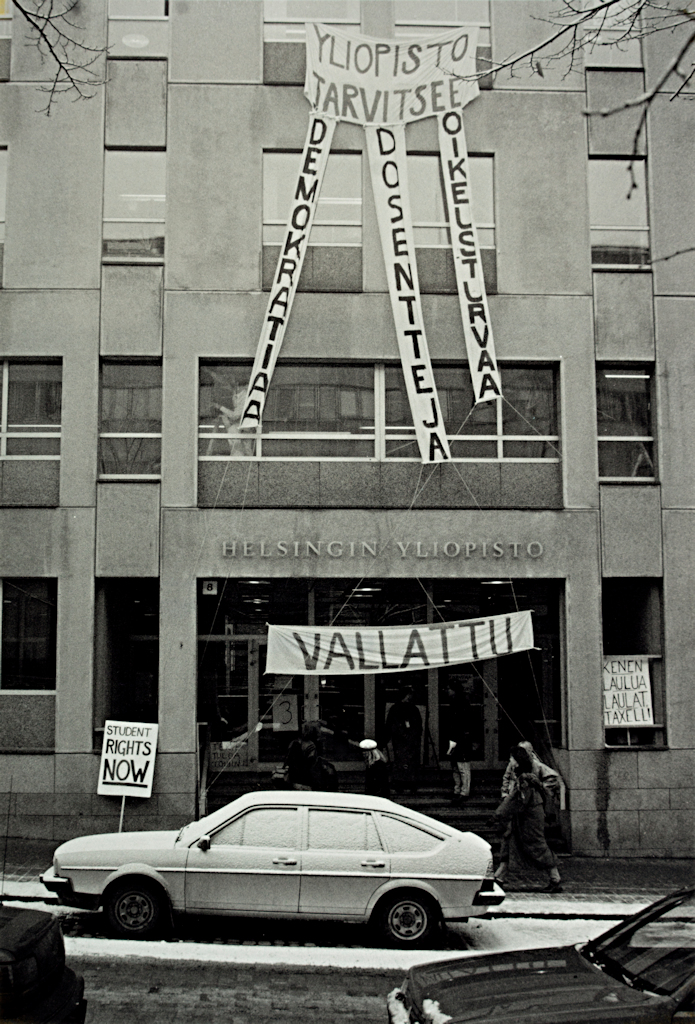The collections of the Helsinki University Museum include several signs and banners used in protests and demonstrations. One of them is a 30-year-old, worn-out cardboard sign stapled to a wooden stick, with the text Älä töni mun dosenttiani (‘Don’t mess with my docent’) written in black felt-tip pen.

A protest and a media event
On 13 February 1990, the Student Union of the University of Helsinki organised a protest outside the Porthania building. Hundreds of students came together to demand putting an end to the professorial majority in the University’s administrative bodies and increasingly including students, teachers and other staff in the University’s decision-making. The students were also concerned about the status of docents, as shown by the sign here, because the teaching provided by docents had been reduced due to cuts in funding for teaching. The text on the sign was apparently spotted by a journalist reporting on the protest because it was included in a list of the students’ demands in the following day’s edition of the Helsingin Sanomat daily. The protest and the following occupation of the University’s administration building attracted much media attention, as was indeed the purpose.
The protest included speeches, music and a play in which a “prosecutor” and “rector” discussed the ruination of academic freedom and democracy.

A polite occupation
The protest ended with hundreds of students marching to the University’s administration building across the street and all the way up to the fourth floor, where the office of the University’s then rector Päiviö Tommila was located. The occupiers negotiated with both the rector and porters on the code of conduct. The occupiers promised to behave in a calm and orderly fashion, while the rector promised that, in accordance with the principle of University autonomy, the police would not be called, but the situation would be dealt with internally.
The occupiers hoisted a black flag on the roof of the administration building. The flag had previously been used as a table cloth by the Limes student association. Banners were also hung from windows with permission from the staff members working in the rooms.

Support and resistance
The occupiers were visited by Minister of Education Christoffer Taxell, who was greeted with shouts of ‘Toffe, Toffe’. The discussion lasted about 90 minutes, but the minister refused to disclose any details of the progress of the legislative process concerning the administration reform. Taxell admitted that if he had been one of the occupiers, he too would have been dissatisfied with his own answers.
Several parliamentary groups expressed their support for the occupiers’ goals. As the occupation progressed, some 7,000 people signed a petition supporting it. The majority were students, but the signatories also included a few professors and dozens of docents.
A couple hundred occupiers stayed the night in the building. According to Helsingin Sanomat, the occupiers covered the overtime pay incurred by porters as a result of their overnight stay. However, this information cannot be found in other sources, such as the Ylioppilaslehti student magazine. Rector Tommila asked the occupiers to leave the building, appealing, for example, to the considerable amount of cash in the building due to the simultaneous strike by bank employees, as a result of which the University intended to pay the salaries of some 4,000 staff members in cash. Tommila was afraid of “total outsiders entering the administration building with criminal intent under the pretext of the occupation”. However, the matter was eventually resolved, and the occupiers spent two nights and a total of 54 hours in the building. The salaries of University staff were also paid on time without a hitch. Before leaving the building, the occupiers cleaned the premises.
In November, it transpired that most of the students’ minimum requirements had been fulfilled in the bill presented to the Parliament. The bill was passed in December 1991.
Susanna Hakkarainen, project planning officer
Translation: University of Helsinki Language Services.
Sources:
Helsingin Sanomat, 14 and 15 February 1990.
Kolbe, Laura 1996: Eliitti, traditio, murros. Helsingin yliopiston ylioppilaskunta 1960–1990. Keuruu.
Kortti, Jukka 2012: Ylioppilaslehden vuosisata. Tallinna.
Tommila, Päiviö 1992: Tunne yliopistosi. Puheita ja kirjoituksia. Helsinki.
Ylioppilaslehti, 22 February 1990.
